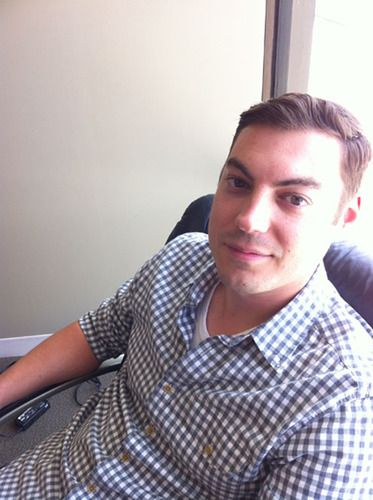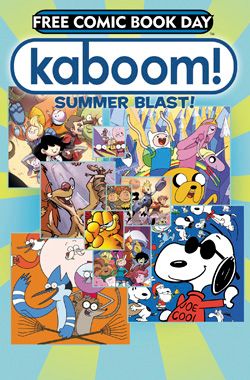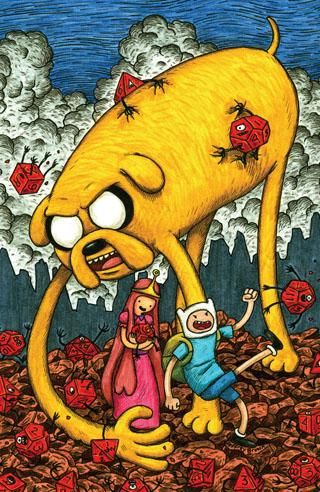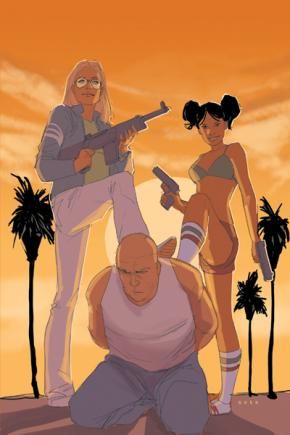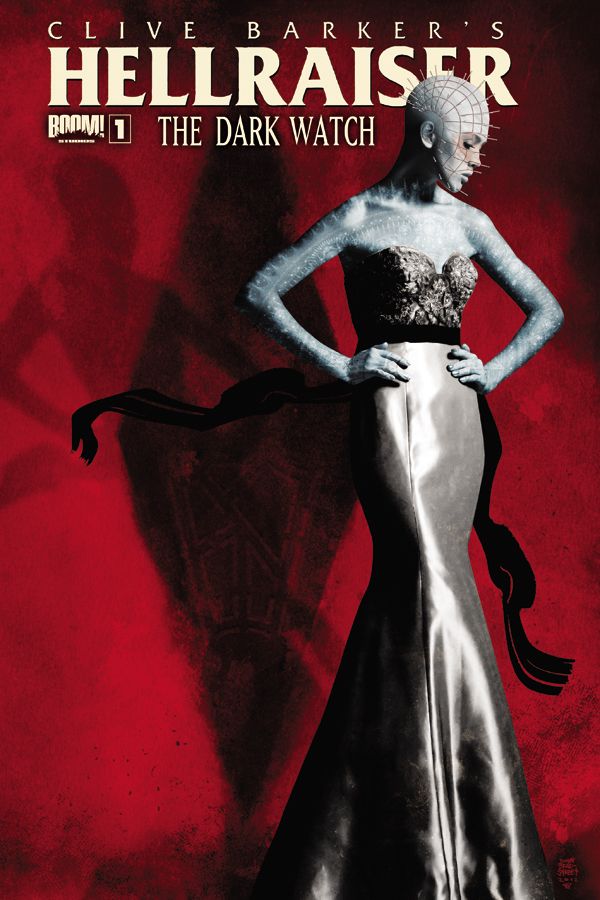Although I've known him for a few years from frequent drop-ins at the BOOM! Studios booth on the convention circuit, I haven't ever had the opportunity to interview Matt Gagnon, the company's editor-in-chief. So I jumped at the chance to talk to him for ROBOT 6's anniversary.
Matt Gagnon joined BOOM! in 2008 to edit its Farscape comics after working as buyer and purchasing manager for Hollywood’s Meltdown Comics. He moved up fairly quickly, becoming managing editor, then editor-in-chief when Mark Waid was named chief creative officer in 2010. This past year saw the launch of BOOM!'s ultra-popular Adventure Time comic book, as well as several other kids' series as a part of the KaBOOM! line. The publisher also announced a new Hellraiser series and put out several original series, like Higher Earth, Freelancers (which Gagnon co-created) and last week's Deathmatch, just to name a few.
My thanks to Matt for his time, as well to BOOM!'s Filip Sablik, who helped set it all up.
Robot 6: When I think about BOOM!'s 2011 vs. 2012, there was a shift away from what I have thought of as "cornerstones" in your publishing line-up -- in particular the Disney comics, which anchored your kid's line; the Stan Lee line; and the Mark Waid-written Irredeemable/Incorruptible titles, which ended in 2012. Obviously you guys publish a lot more than that, but as editor-in-chief, when you see those sorts of shifts coming and realize you won't be publishing titles that make up a big part of your identity, what's your reaction and how do you start to plan to fill those holes?
Matt Gagnon: Never get comfortable. Comic-book publishing is ever-changing, so a big part of being successful is your ability to constantly adapt, innovate, execute. I have a lot of confidence in our team so as far as a reaction I try to look at these types of shifts as an opportunity to improve. And that’s not to undervalue something like Irredeemable, which we’re incredibly proud of, but each year brings with it a new set of challenges and opportunities that you face. For me, I want to hit more home runs and RBI’s than the year before, you know? You always have to stay hungry.
And when it comes to planning that’s something you never stop doing. It’s funny, when I look back at the shift from the Disney comics and Irredeemable I can see how it would seem so sudden. But having gone through that it felt much more like a gradual experience. We’ve always been committed to publishing all-ages comics and as a result we were already planning for ways to expand the imprint. When we launched KaBOOM! after the Disney comics we were prepared because of that planning. Peanuts didn’t happen overnight, nor did Garfield.
There’s a relentless spirit that I love about how we operate. When the Disney comics went away there were a lot of folks speculating a decline for the company -- and that’s going to happen, I get it -- but our attitude was let’s go out and double down. Let’s create something bigger and better.
The kid's line, in particular, came out of the licensing deal with Disney, and once that was gone, you guys bounced back pretty well with Peanuts, Adventure Time, Garfield, Bravest Warriors and, I understand, a Regular Show comic (if the Free Comic Book Day solicitation is to be believed). As these are licensed titles, what do you look for in an outside property that indicates it could make for a good comic?
What’s this Regular Show you speak of, JK?!
Choosing a licensed property, whether it’s for BOOM! or the KaBOOM! imprint, always starts with whether or not we have an affinity for the material. It has to start there. If you don’t have a POV on the license and can’t create something authentic it will immediately show up on the page. I loathe licensed comics that are done poorly. One of my personal missions ever since I’ve been at BOOM! is to change the way people think about licensed comics. I’ve said this before: I don’t want to just do a Planet of the Apes comic book, I want to do the best Planet of the Apes comic book. And that goes for everything from Adventure Time to Hellraiser. I want to respect our readership and deliver comics that satisfy creatively.
We’ve been building that reputation. I can’t tell you how many fans and retailers have expressed their gratitude for how we handle licensed properties. I had a prominent retailer tell me recently that he wished some licenses at other companies were in our hands. It’s gratifying to hear that our efforts aren’t going unnoticed.
I spoke with Shannon Watters at the Alternative Press Expo about Adventure Time and the creators who have worked on it thus far. I thought it was interesting seeing the BOOM! Town stuff next to a whole bunch of Adventure Time comics at your booth, and noting both the creators who have worked on it and the fans who are reading it. Can you talk a little bit about the appeal of Adventure Time, both as a kid's comic and the kind of comic that attracts folks who attend APE? Was that the sweet spot you were hoping for, or did it surprise you that it had such mass appeal?
The success of Adventure Time was definitely a surprise. Leading up to the launch we knew that the series was going to be very popular--and that it was under-ordered--but it still blew our expectations out of the water when it finally hit stands. The reorder activity was like nothing we had ever seen. We were setting robust print runs and watching them disintegrate in a matter of weeks.
The creative approach for the series was something we had devised from the beginning. We knew we wanted a lead story in every issue that was more “on model” and we wanted back-up stories by different creators each issue that featured short stories in their own style. We wanted every issue to be special. The idea is that you get something genuinely new every issue, every month. When we pitched out this concept to Cartoon Network and Pendleton Ward (the show creator) they were 100 percent supportive. Once that format was in place we felt like we were going to be able to deliver something special.
The Land of Ooo is literally wide open with endless story possibilities. That elasticity, and the way all the talent involved with Adventure Time push the stories is so refreshing. It has heart and it’s unabashedly fun and it’s not afraid to be absurd and not take itself too seriously. Anybody who has a heart beat should be able to enjoy it. The best way for us to honor the show was to push the envelope in our own way and really utilize the advantages of the comic book medium.
All the alternative comics and web comics talent involved with the series are phenomenal. That was an intentional choice of ours, and an important one. In many cases these cartoonists are able to be more experimental and take more risks working largely outside of the normal industry structure. That type of creativity IS the spirit of Adventure Time. It was essential to embrace that.
In the cases of Adventure Time and Hellraiser, in particular, how involved are the creators of those properties, and how important is it to have the original creator involved in the comics?
Any time you can have the creator involved in the comic book series it’s a boon. Again, the goal is for these comics to be as authentic as possible and you can’t be much more authentic than having the creator’s voice involved in the process.
We’re very lucky in that Pendleton Ward is heavily involved with the Adventure Time comics and Clive Barker is not only involved, but also charting the course for our Hellraiser comics. Incidentally, it’s interesting that you singled out Adventure Time and Hellraiser as both creators of those franchises are legit, true blue comic book readers. Believe me, that helps so much.
In addition to the licensed titles you guys produce, we've also seen a lot of original titles come from BOOM! this year -- Freelancers, Supurbia, Higher Earth, Hypernaturals and the just-released Deathmatch, to name a few. I know this is an area you're passionate about, so talk a little bit about how you find these sorts of projects. Did they come in as pitches, or did you reach out to the creators involved in them?
Publishing original comics is what the company was founded on. We’ll always publish original comics, and you’re absolutely right, it’s something we’re passionate about. One of the primary reasons I came to BOOM! was because Ross and I both believed in the importance of telling new stories. I personally believe that we as an industry need to be publishing a diverse array of genres (like every other entertainment medium). I don’t know many people in my day-to-day life that only consume one genre of entertainment. It’s not uncommon for most people to dig James Bond as much as Game of Thrones, or Mad Men, or Star Wars.
I like publishing a wide variety of stories. When somebody walks up to our booth at a convention it doesn’t matter who they are or what they’re interested in, I know that we publish something they can get into.
How we find these original projects tends to be pretty organic. We typically identify creators whose work we enjoy and ask them if they’d like to pitch. There’s also the outside-in approach where we’re contacted by professionals who have something they think would be a good fit for us. You never know where a good idea will come from so we try to be as receptive as possible now matter how aggressive the entire pitch process can be!
In general, how do you go about finding and helping to develop new talent? I'm hoping you could answer this question in two ways, both from the creator (i.e. writer/artist) perspective, and also in terms of your editorial team.
Absolutely. Developing new talent is one of the cornerstones of our business. We work in a creative industry, and as a result your creative vision is one of the things that sets you apart. I love, love, love discovering and developing new talent across the entire spectrum. We’ve had a lot of success with this over the years. How to find new talent is different for everybody. I’m sure every editorial team has their own process, kind of their own secret sauce. Just assuming for the sake of discussion that everybody looking has an eye for talent, the actual process of finding new talent can be painstaking but it’s absolute magic when something clicks.
Now, how to develop new talent is a broader, unwieldy topic. I could probably fill up a book on this, but I’ll over-simplify it by saying “start small.” Nothing will crush an artist/writer faster than throwing them into the deep end when they’re not ready. It’ll make everybody’s life miserable. One of the ways we try to avoid this is by having younger artists test for projects. It might just be a couple pages, and even if they ultimately don’t get the project they’re still receiving feedback from editors, getting their work in front of professionals, and building relationships. And on our end we can gauge how quickly they’re working, how well they apply feedback, and what their level of professionalism is.
What we try to explain to everybody is that the tests don’t go away. You can make a lasting impression. There are so many times I go back to an old test and say, “Hey, this artist had some real potential. Let’s check in and see if they have any new pages.”
As for how we develop editors, nothing helps more than being in the office and immersing yourself in the process. You mentioned Shannon Watters earlier. She and Dafna Pleban are two of our (awesome) “veteran” editors. They started out as assistant editors; I was fortunate enough to mentor both of them, and they’ve since been promoted to positions where they’re passing down their experience to the newer members of editorial. Our managing editor, Bryce Carlson, started off on a similar track and worked his way up.
Until colleges start offering degrees for editing comics it’ll remain a mentor/apprentice developmental relationship!
On a personal note, what are two to three lessons you've learned in your time as editor-in-chief over the past couple years?
I have a quote hanging next to me in my office that says, “The two most important things in life are good friends and a strong bullpen.” It was coined by Hall of Fame baseball pitcher Bob Lemon, but I find it humorously appropriate for working in comics. What you can accomplish as an individual is nothing compared to what you can accomplish with a team that supports one another.
Hire good, talented people and empower them to do their best work. Put them in a position to succeed. No ego. No drama. If your team is motivated and working toward a clear, common goal it will show in the work you produce. Everybody should have a voice. If you hire smart people, you should LISTEN to them. These are shocking concepts, right?!
I expect everyone to deliver their best work, respect one another, and rally when the going gets tough. I seriously could not be prouder of the team we have over here. I love coming to the office every day. We work tirelessly, but there’s a fair amount of the bullpen jamming out to Lionel Richie and Huey Lewis. Actually, the two things aren’t mutually exclusive. The widespread Lionel Richie and Huey Lewis love might make me the most proud of all.
What do you see as the biggest challenges coming in 2013, both from the BOOM! perspective, and for the comics industry in general?
Expanding our readership, both from the BOOM! perspective and the industry in general. It’s an ongoing battle. Ask me again next year, but from where I’m sitting now at the end of 2012 I’m optimistic. I’m seeing some really smart direct-market retailers figuring out innovative ways to grow their businesses. It’s especially encouraging to see more publishers and retailers working together on custom variants and marketing initiatives. Digital is still expanding our reach incrementally and there’s a healthy competitiveness between publishers that I believe is leading to better work.
It takes all of us. I feel like the difference between 2011 and 2012 is staggering (for the better), and I’d like to see us take it to the next level in 2013.
And finally, how do you see the editorial line expanding in 2013? What are you most excited about?
Remember those plans I was talking about earlier? We have more of those. You can expect the KaBOOM! imprint to see some new faces added to the line-up. The BOOM! slate will feature a host of new originals and licenses that are going to make people’s heads spin.
We also have our first feature film, 2 Guns, coming out in August via Universal Pictures. That’s more than a little surreal!
Stay tuned for announcements, of course. There’s a prominent writer I’ve always wanted to work with that we’re launching an ongoing series with in 2013. I’m really excited about that. We’ll be making the announcement for it mid-February.
To a great 2013, everybody!


